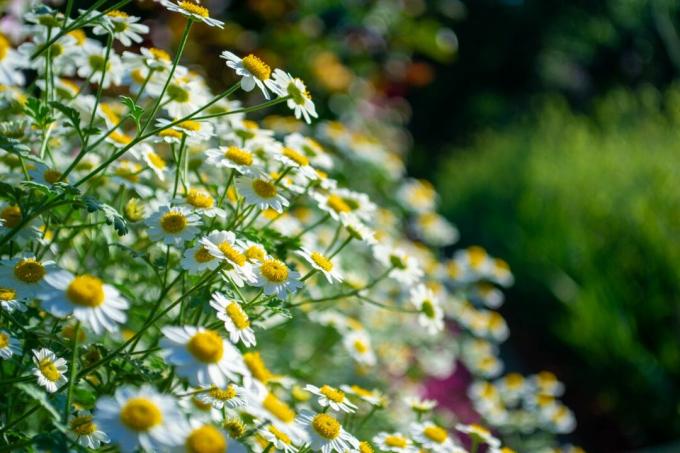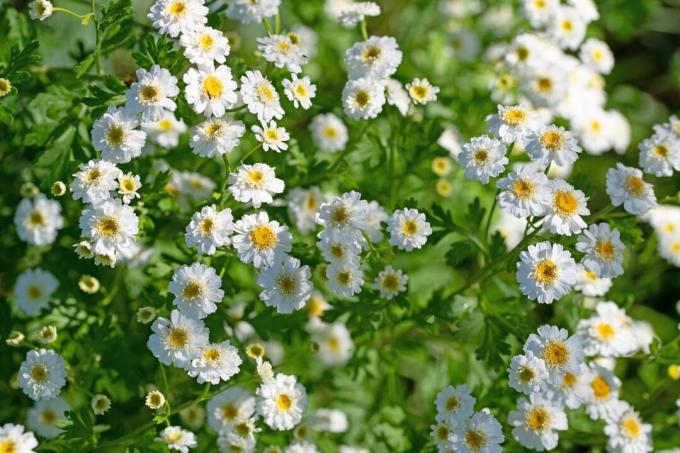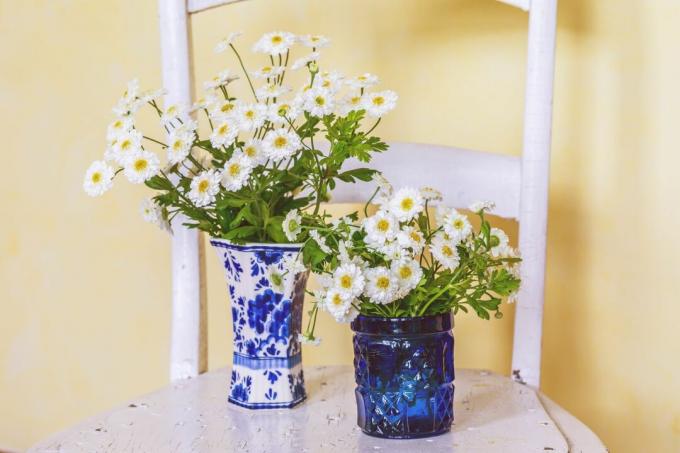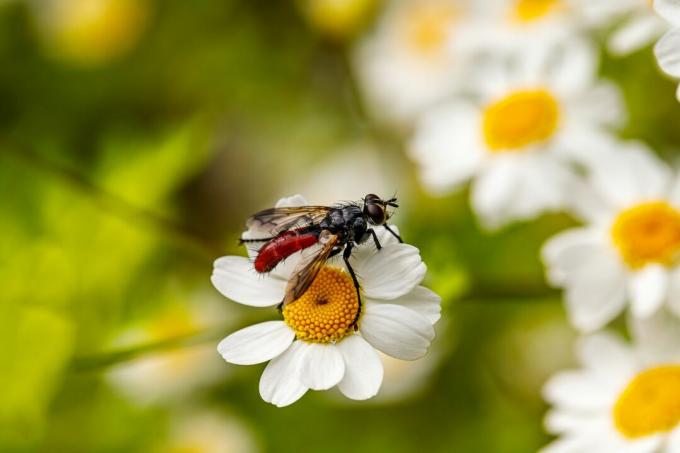Feverfew is a well-known and popular medicinal plant. But what effect does false chamomile have? How to plant, care for and harvest them? With us you will learn everything about feverfew.

Feverfew has been a well-known medicinal herb for over 2000 years and has been deliberately cultivated ever since. The German name of the als Tanacetum parthenium known herb used during pregnancy: It is said to induce labor and speed up delivery. In the Middle Ages it was even administered in large quantities and was intended to induce an abortion. You can find out from us how to grow false chamomile in your garden at home, how it is properly cared for and what else you can use it for.
contents
-
False chamomile: properties and origin
- Risk of confusion with feverfew
- Is false chamomile a weed?
- The main species of Tanacetum parthenium
- plant feverfew
-
Caring for false chamomile
- Harvest, use and medicinal properties of feverfew
- Is feverfew poisonous?
False chamomile: properties and origin
Originally, feverfew is native to south-eastern Europe and the eastern Mediterranean, but because of its well-established, widespread distribution throughout Europa is viewed as an archaeophyte - a plant that is alien but spread through human cultivation a very long time ago became. In addition, feverfew can now be found in large parts of the world, for example in northern, central and South America, Oceania, large parts of Asia, North Africa, the Azores and Canary Islands, where it is considered Neophyte applies. Occasionally, the herbaceous and perennial plant is also known as false chamomile, ornamental chamomile or fever herb - this always means the Tanacetum parthenium, which belongs to the daisy family (Asteraceae). In the past, there was a long disagreement about the genus: Feverfew was first given to camomile (Matricaria) assigned before adding them to the chrysanthemums (chrysanthemum) counted. However, nowadays it is considered a part of the wildflowers (tanacetum) classified.

The herb, traditionally cultivated as an ornamental and medicinal plant in cottage gardens, grows between 30 and 80 cm high and forms delicate, pinnate leaves about 8 cm long. Feverfew is particularly noticeable because of its strong scent. The stem is ribbed and branches upwards while becoming woody near the base. Between May and August, the plant develops its flowers, which are around 1.5 to 2 cm in size and grow in umbel-like racemes or panicles. Its yellowish appearing flower head of yellow tubular flowers, framed by white ray florets, is characteristic. The flowers form a food source for some wild bee species such as the common silk bee (Colletes daviesanus) and the tansy mask bee (Hylaeus nigritus), but is also popular with honey bees and flies. Feverfew is therefore bee-friendly. Their fruits are classified as achenes. They are relatively small, grooved, and have small appendages, the pappus, which enable them to spread either by wind or with the help of passing animals.
Risk of confusion with feverfew
Feverfew can easily be confused with other plants for two reasons: Firstly, the bird sees it real chamomile (Matricaria chamomilla) and the meadow daisy (Leucanthemum vulgare) confusingly similar, on the other hand, the Alpine orchard (Mutellina adonidifolia) occasionally called "Feverfew".

In contrast to real chamomile, the flower base of feverfew is significantly flatter, while real chamomile has a rounded, upwardly curved and hollow head. The flower of the real chamomile smells stronger than that of feverfew. The two plants also differ in the length of their white petals, which are significantly shorter in feverfew. The areas of application are diverse. In our special article you can find out all about the Chamomile, the queen of medicinal herbs, read up. In contrast, the meadow marguerite can be easily distinguished by its leaves: it forms coarsely toothed basal leaves in Columnar shape and leaves with few serrate to entire margins in the upper area, while feverfew leaves are pinnately lobed are.
Is false chamomile a weed?
Even if feverfew is often referred to as a weed, this is completely wrong. The mother chew has been used as a medicinal plant for thousands of years and is specifically cultivated in medicinal and cottage gardens.

The main species of Tanacetum parthenium
Some Feverfew varieties have been produced through breeding and natural selection. We present the most popular:
- ˈGolden Mossˈ: The plant, also known as golden-leaved feverfew, lives up to its name because it adorns itself with shimmering yellowish-green leaves all year round. The flowers are feverfew's typical yellow baskets with white petals, blooming between June and September. Tolerates in a sunny location Tanacetum parthenium ˈGolden Mossˈ even withstands temperatures down to – 20 °C without any problems and grows quite small, only a maximum of 20 cm high.
- ˈAureumˈ: The yellow-leaved feverfew, like the golden-leaved feverfew, develops leaves with a yellow tinge, which is less noticeable in this variety. Flowers and growth are also typical of feverfew. Tanacetum parthenium ˈAureumˈ even grows up to 80 cm and can easily be overwintered in the bed.
- ˈpleniflorusˈ: The flowers of the double feverfew are particularly striking, and because of their abundance they differ visually from the other varieties. In good conditions it also grows up to 80 cm high and flowers between June and September. Temperatures of down to – 18 °C are no problem for the stuffed feverfew.

plant feverfew
Feverfew can be planted in your own garden without much effort. It should be noted that the plant naturally grows on loamy, nutrient-rich soil with moderate moisture. An appropriate location with a neutral pH offers advantages for the culture, whereby sandy or gravelly soils are still accepted. In addition, the soil should not dry out, as this is just as badly tolerated by feverfew as waterlogging. Feverfew thrives in full sun without any problems, but can also be planted in shaded locations. In the spring, the first pre-grown plants are available in the garden center and can be placed directly in the bed. 2 to 4 plants per square meter can be planted in previously dug planting holes - without planting them deeper than they were in the pot before. Slightly pressing down ensures good soil contact and subsequent watering promotes growth.

Alternatively, feverfew can be pre-cultured from March. For this purpose, appropriate seed containers are filled with high-quality seed soil that has a reduced nutrient content to promote root growth. For example ours Plantura Organic Herb & Seed Soil Promotes the root growth of the young plants through the specifically reduced nutrient content and takes care of it in advance thanks to its airy, loose structure for optimal growth conditions for germination without silting up. In addition, our seed soil is completely harmless for pets and garden animals because of the completely natural raw materials. Since feverfew germinates in the light, the feverfew seeds should only be placed on the ground and pressed lightly without being covered by the substrate. Thoroughly poured on, the seed pot can be covered with a transparent film in which a few holes are pierced. This creates a kind of mini greenhouse that provides the seeds with optimal germination conditions and high humidity. The seeds will germinate after 2 to 3 weeks in a bright place at around 15 °C. If the pre-cultivation of feverfew is too time-consuming, you can wait until April and sow the seeds directly outdoors using the same principle.
Caring for false chamomile
False chamomile is generally quite undemanding and needs little care, even during the summer. Watering of the herbaceous plant is only necessary during longer periods of drought. Faded inflorescences should be cut out before the seeds are ready to prevent self-seeding. For targeted self-sowing without letting the false chamomile grow rampant, individual inflorescences can be left on the plant and ripen. Bloated shoots may be pruned back vigorously to promote bushy growth of the plant. Fertilization is not necessary for an annual culture of feverfew, for perennial culture can spread some organic fertilizer such as manure or compost around the plants in spring will. Alternatively, a high-quality, ecological long-term fertilizer in granular form is used, which only releases its nutrients through microbial conversion in the soil. For example, our is suitable for this Plantura organic universal fertilizer, which, thanks to its balanced nutrient ratio, also provides herbs such as feverfew with optimal care.

Is feverfew hardy? Feverfew is often planted as an annual summer flower, but can easily be planted as a perennial, herbaceous Plant can be cultivated and tolerates frosts down to -12 °C, some varieties even down to -20 °C without problems. The feverfew grows persistently, so the above-ground parts of the plant do not die. However, it should be cut back before the onset of frost to facilitate hibernation. Somewhat protected against cold winds and the intense winter sun, for example by means of a fleece or a straw mat, the feverfew will be supported over the winter. However, it is important to ensure that the cover is permeable to air and moisture and that there is no accumulation of air or moisture underneath, which can damage the plant in the long term. Feverfew should be watered lightly on frost-free days, as water evaporates through the leaves even during the winter.
Harvest, use and medicinal properties of feverfew
Between June and October is feverfew harvest time, once the flowers have fully opened. As with real chamomile, these are then snapped off just below the inflorescence with your fingers or garden shears. The flowers should be spared as much as possible and not damaged.

Feverfew has been used as a medicinal plant since the first century. In the Middle Ages it was mainly used for its antipyretic and headache-relieving effects, which explains the English name "feverfew", which can be translated as "less fever". However, it owes its German name to its use against pregnancy symptoms, the induction of labor and its speeding-up effect on labor. In addition, feverfew was administered in high doses in the Middle Ages to specifically trigger an abortion. In lower doses and for internal use as feverfew tea, tincture or extract, it can help against rheumatism or inhibit inflammation. Taken long-term, it is said to prevent migraine attacks, help against intestinal parasites and promote digestion. Applied externally, feverfew can help to cleanse the skin and protect against insects, as its smell scares insects away. It can also be used as a hair conditioner against lice.
Not only cultivated and used as a medicinal plant, the feverfew is ideal, it is also an eye-catcher simply as an ornamental plant for the garden. It is particularly effective as an underplanting in combination with other flowering perennials such as roses. False chamomile even cuts a fine figure as a cut flower in a vase.

Is feverfew poisonous?
In general, false chamomile is not poisonous, but in high doses it can lead to an abortion in pregnant women. In addition, all parts of the plant above ground contain ingredients that are considered contact allergens. People with a daisy family allergy react primarily to the substance parthenolide, which can trigger an allergic reaction. The plant does not pose a threat to most animals, but feverfew is poisonous to rabbits and should never be fed.

The false chamomile alone looks a bit bare in your garden? With our tips you will learn how to create one Put on the herbal spiral correctly.



